Abstract
Making use of the discriminant sequence for polynomials, WR algorithm, Wu’s elimination and a partial cylindrical algebraic decomposition, we present here a practical algorithm for automated inequality discovering which can discover new inequalities automatically without requiring to put forward any conjectures beforehand. That is complete for an extensive class of inequality-type theorems. Also this algorithm is applied to the classification of the real physical solutions of geometric constraint problems. Many inequalities with various backgrounds have been discovered or rediscovered by our program, DISCOVERER, which implements the algorithm in Maple.
Similar content being viewed by others
References
Folke, E., Which triangles are plane sections of regular tetrahedra? American Mathematical Monthly, Oct., 1994, 788.
Guy, R. K., Nowakowski, R. J., Monthly Unsolved Problems, 1969–1997, American Mathematical Monthly, Dec., 1997, 967.
Yang, L., Zhang, J. Z., Hou, X. R., An efficient decomposition algorithm for geometry theorem proving without factorization, in Proceedings of Asian Symposium on Computer Mathematics 1995 (eds. Shi, H., Kobayashi, H.), Scientists Incorporated Japan, 1995, 33–41.
Yang, L., Zhang, J. Z., Hou, X. R., Nonlinear Algebraic Equation System and Automated Theorem Proving (in Chinese), Shanghai: Shanghai Scientific and Technological Education Publishing House, 1996.
Yang, L., Xia, B. C., Explicit criterion to determine the number of positive roots of a polynomial, MM Research Preprints, 1997, (15): 134–145.
Liang, S. X., Zhang, J. Z., A complete discrimination system for polynomials with complex coefficients and its automatic generation, Science in China, Series E, 1999, 42(2): 113.
Yang, L., Recent advances on determining the number of real roots of parametric polynomials, Journal of Symbolic Computation, 1999, 28: 225.
Zhu, S. M., Wu, X. M., Computer application to ordinary differential equations and soliton, Mathematical Technology for 21st Century (eds. Yang, L., Liang, S. X.) (in Chinese), Guangzhou: Guangdong Economy Publishing House, 1999, 32–39.
Wang, L., Yu, W. S., Complete characterization of strictly positive real regions and robust strictly positive real synthesis method, Science in China, Series E, 2000, 43(1): 97.
Yang, L., Hou, X. R., Zeng, Z. B., A complete discrimination system for polynomials, Science in China, Series E, 1996, 39(6): 628.
Chen, M., Generalization of discrimination system for polynomials and its applications, Ph. D Dissertation, Sichuan Union University, 1998.
González-Vega, L., Lombardi, H., Recio, T. et al., Sturm-Habicht sequence, in Proc. of ISSAC’89, New York: ACM Press, 1989, 136–146.
Arnon, D. S., Collins, G. E., McCallum, S., Cylindrical algebraic decomposition I: The basic algorithm, SIAM J. Comput., 1984, 13(4): 865.
Arnon, D. S., Collins, G. E., McCallum, S., Cylindrical algebraic decomposition II: An adjacency algorithm for the Plane, SIAM J. Comput., 1984, 13(4): 878.
Winkler, F., Polynomial Algorithms in Computer Algebra, Wien: Springer-Verlag, 1996.
Wu, W. T., On the decision problem and the mechanization of theorem-proving in elementary geometry, Sci. Sinica, 1978, 21: 159.
Wu, W. T., Mechanical Theorem Proving in Geometries: Basic Principles, Berlin: Springer-Verlag, 1994.
Gao, X. S., Cheng, H. F., On the solution classification of the “P3P” problem, in Proc. of ASCM’98 (ed. Li, Z.), Lanzhou: Lanzhou University Press, 1998, 185–200.
Yang, L., A simplified algorithm for solution classification of the perspective-three-point problem, MM Research Preprints, Beijing, 1998, 135.
Mitrinovic, D. S., Pecaric, J. E., Volenec, V., Recent Advances in Geometric Inequalities, Amsterdam: Kluwer Academic Publishers, 1989.
Briggs, W. E., Zeros and factors of polynomials with positive coefficients and protein-ligand binding, Rocky Mountain Journal of Mathematics, 1985, 15(1): 75.
Wyman, J., The Binding potential, A neglected linkage concept, J. Mol. Biol., 1965, 11: 631.
Author information
Authors and Affiliations
Rights and permissions
About this article
Cite this article
Yang, L., Hou, X. & Xia, B. A complete algorithm for automated discovering of a class of inequality-type theorems. Sci China Ser F 44, 33–49 (2001). https://doi.org/10.1007/BF02713938
Received:
Issue Date:
DOI: https://doi.org/10.1007/BF02713938




